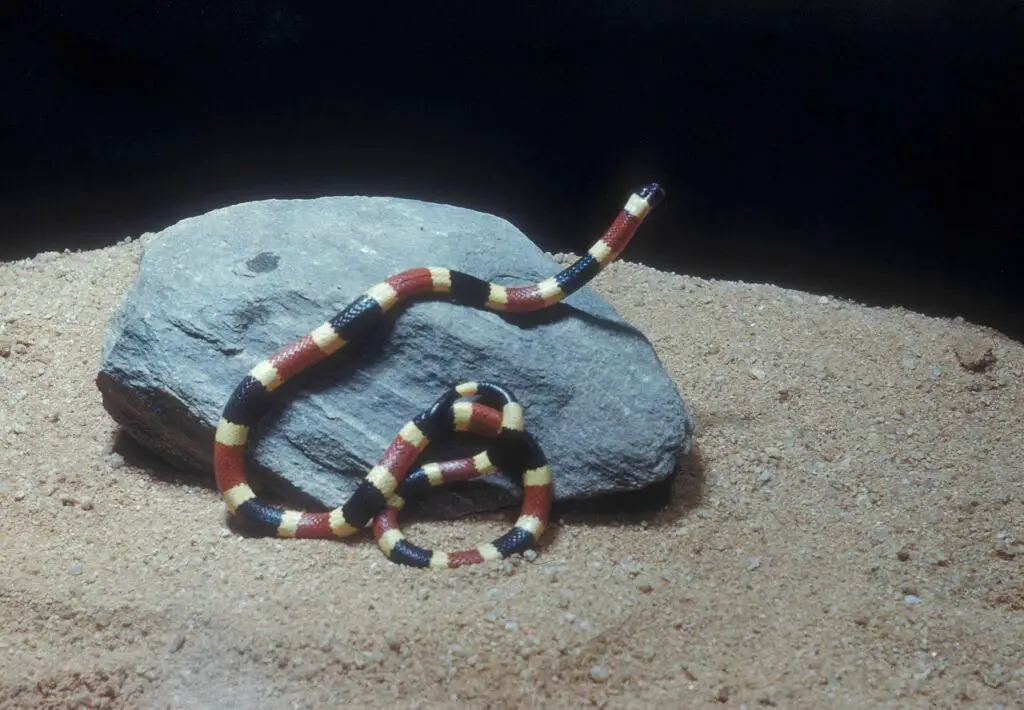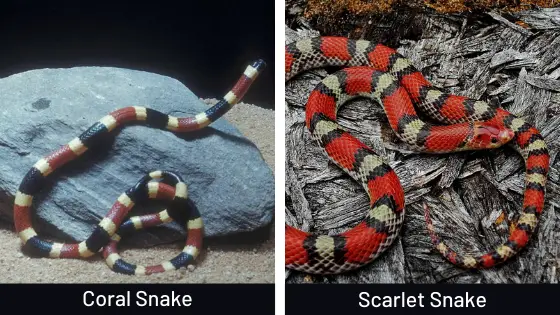How Venomous is a Coral Snake? Things You Need To Know!
Are Coral Snakes really venomous?
Coral snakes are venomous and not poisonous. They are venomous because when they bite they inject their venom into the body of their prey.
And, they are not poisonous because they don’t secrete poison toxins from their body surface. So, don’t ever say, “Coral Snakes are poisonous”, but you can say correctly, “Coral Snakes are venomous.”
As described there are about 16 species of Old World coral snakes in three genera (Calliophis, Hemibungarus, and Sinomicrurus), and over 65 recognized species of New World coral snakes in three genera (Leptomicrurus, Micruroides, and Micrurus).
These are all very small, vibrantly colored, highly venomous snakes. They are mostly notable due to their red, yellow/white, and black colored banding.
Their fangs remain constantly in an out and erect position and they do have a less effective venom-delivery system through their fangs.
It’s because although their venom is highly toxic, but they don’t carry much venom in their fangs. This is also why you will often see them holding onto their prey for some time, and also they bite their prey many times.
Even their newborn babies are brightly colored and fully venomous and have a size of only about 7 inches (17 cm) long.

How venomous are Coral Snakes?
Coral snakes are highly venomous and they contain neurotoxic venom. They are so venomous that some of the species of the Coral snakes like the Eastern coral snake (Micrurus fulvius) are included in the list of Top 10 deadliest snakes in North America.
But, one positive point is that they are very reclusive and rarely seen. So, the death rate of humans being bitten from these snakes is very low.
Another important thing is that the coral snake has very little control of how much venom it can inject into its prey or victim. But, if it is able to give a perfect bite then at any one time, it can insert enough venom to kill an average of five people.
But still, a safe to hear fact about the Coral snake is that it can only inject an extremely small amount of venom in its most defensive bites.
It is included in the list of the Top 10 deadliest snakes in North America because its one perfect bite can contain enough dose to kill a human within two hours, making this snake one of the deadliest on the list.
Their venom injection rate is pretty much low and so it takes time for the victim or the prey to be die after the first bite.
So, that’s why coral snakes keep on biting and holding onto their prey so that more venom gets injected to kill their prey at a much faster rate.
What type of venom do Coral Snakes have?
Coral snakes do have a neurotoxic type of venom. Their venom can cause rapid paralysis and respiratory failure in its prey.
But, as because they have a low effective poison, it takes a few hours for a victim to see the symptoms of severe sickness after the first bite. But, if the victim is bitten quite a few times by the snake then it can be really fatal.
If a minute envenomation occurs, then the snake’s neurotoxic venom can produce extreme pain and difficulty in breathing but not death due to the little dosage of venom. And, if a proper envenomation occurs then it will surely lead to death if not cured.
So, you won’t know how the coral snake will bite you, as that action totally depends on its involuntary wish. So, better to stay away from such snakes.
And, yes it’s true that their venom contains powerful neurotoxins and that will surely cause acute pain and if left untreated then it can lead to a severe heart attack. There is usually only mild pain associated with a bite, but respiratory failure can occur within hours.
Their neurotoxic venom is well noted to cause paralyzation in the breathing muscles thus blocking the mechanical or artificial respiration process. So, often you find the physician applying large doses of antivenom to save a victim’s life after the bite.
Symptoms are usually delayed for about 12 hours or a bit less, as seen. The neurotoxin can also disrupt the connections between the brain and the muscles blocking the muscular synapses.
Their venom can also cause symptoms like slurred speech, and double vision, just before the muscular paralysis and respiratory or cardiac failure occurs.
Coral snake’s venom once entered into the victim’s blood is known to block both pre and post synaptic signals of the neurons.
This synaptic signal blockage also causes not only myotoxicity (toxic effect on muscle and myoglobin), but also rhabdomyolysis which is the breakdown of damaged skeletal muscle and releasing of the myoglobin into the bloodstream.
How does the Coral Snake venom work?
The mechanism of working of the Coral snake venom is pretty much the same as that of the other neurotoxin releasing organisms like Scorpion, and most vipers, and cobra species.
Coral snakes deliver their venom through their bite in a very distinctive way due to the presence of a pair of fangs that always remain in an erect way. These fangs are positioned at the front of their mouth.
Since their fangs are very short and fixed and erect, so they deliver their venom through chewing motions.
Meaning that they will give the first bite to their prey and will inject the first dose of venom and will hold it by further bitting, and will keep bitting and swallowing the prey slowly.
As a result, the venom gets injected more and more into the prey.
And, as the venom takes enough time to show its full deadly effect, so unlike other vipers, Coral snakes don’t strike and bite quickly and let the prey go. In fact, they do hold them and start further bitting and swallowing it alive before it can escape.
The venom contains enzymes and other proteins that are neurotoxic in nature. These once entered into the blood exhibit strong neuron interfering processes.
At first, the victim will feel acute pain, and slowly within hours, the toxin will start to block the ion channels between the neuro-muscular junction, thus inhibiting the proper muscle relaxation and contraction.
Thus, due to this, the muscle cells are not able to detect when to relax or contract periodically. As a cause, the muscles in the victim’s body start to bend first from the site of the sting bite to the whole body slowly, and thus paralysis happens.
Slowly after some time due to more neuro-muscular synapse blockages, the connections between the brain and the muscles also get blocked, thus causing slurred speech, double vision, and more muscular paralysis.
Thus, all of these neurotoxin symptoms finally lead to eventually ending in a more severe respiratory or cardiac failure.
Can a Coral Snake bite kill you?
Coral Snakes relatively pass low dosage of venom at their fast bite so, only a single bite of the coral snake won’t kill a human.
But that very bite is venomous enough to cause extreme pain and can make you fall ill with symptoms like excessive sweating, nausea, vomiting, hypersalivation, and restlessness.
Their first bite may not be so deadly to adults, but children, the elderly, and immunocompromised people are mostly at risk. And, if the snake has bitten a few times then it is extremely lethal and needs to be cured as soon as possible.
They are rarely seen and so they stay away from humans. So, the fatal cases caused due to coral snakes bite are very rare.
They only bite if provoked, or stepped upon, or after being agitated. Else, they are of shy nature and try to stay away from humans.
Normally, Coral snakes may only inject a small venom dosage during their first bite. But if they get highly provoked and distracted, then their bite could be a perfect venomous bite with the highest concentration of venom dosage.
The bite that they can give when they feel agitated or provoked is fatal enough to cause death to 5 humans with that very venom.
So, nobody knows how the snake felt at the time of their bitting. So, better don’t take the risk and run to the hospital as soon as possible if you ever get bitten by a coral snake. Or else, within hours you will die.
What snake looks like a Coral Snake but is not venomous?

The Scarlet snake looks like the Coral snake, but is not venomous at all. One mimics the other, but there are some identification signs to notice in order to identify a Coral snake from a Scarlet snake very well.
Both have the same red, yellow, and black bands around their body but the patterns are a bit different.
People often get confused between the two as they both sustain in the same type of habitat.
When confusion occurs, the first thing you need to notice is that the Scarlet snake will have a red nose, and the Coral Snake has a black nose, at the upper portion of their head.
Also, you will notice that the Coral snake bands will go all the way around its body, whereas the Scarlet snake will have different bellies, that is either being faded or is entirely white.
Coral snakes are limited to a particular geographical range, whereas Scarlet Snakes have a much larger overall range than the coral snakes.
Coral snakes are found in scattered localities in the southern coastal plains from North Carolina to Louisiana, including all of Florida. They can be found in pine and scrub oak sandhill habitats in parts of this range, but sometimes inhabit hardwood areas and pine flatwoods that undergo seasonal flooding.
Scarlet snakes are found in pine flatwoods, hydric hammocks, pine savannas, mesic pine-oak forests, prairies, cultivated fields, and a variety of suburban habitats in the southeastern U.S.
How do you get rid of Coral Snakes?
You may easily come across a coral snake in the uncultivated areas of your yard and around shelters, such as piles of firewood, rocks, or brush.
If you ever come across a coral snake than the best-suggested measure is to leave them alone. They aren’t of aggressive nature and are usually peaceful and shy and so will always stay away from humans.
Don’t ever dare to touch them barehanded or even provoke them or else, they may bite you with a high dosage of venom.
So, better use a trap to catch them and then go and leave them alone at some other places miles away from the human habitat.
One preventive measure you can follow to get rid of such Coral Snakes is by controlling their availability of food like lizards, frogs, and smaller snakes, including other coral snakes.
They live in the wooded, sandy, and marshy areas, and spend most of their lives in underground burrows, or in leaf piles. Better to keep your yard clean and eliminate such stuffs to get rid of the snake.
Also you can use a snake repellent like Mothball Flakes (most commonly used), or Sulfur mixed with Mothball flakes.
Snakes repellent disrupts their function to detect pheromones and other subtle chemical cues from their environments. And so, repellents can drive off snakes away from your yard in search of more comfortable locations.
Above all, it is best suggested that you call your Snake Removal Expert or Team in your area to help you out in getting rid of the Coral Snakes.
